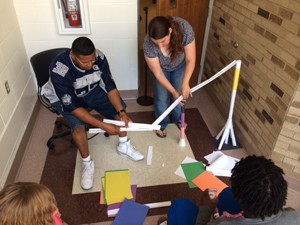
NSF Grant Helps Cincinnati Teachers Spend the Summer as Students
Fourteen school districts in the Cincinnati area are participate in a University of Cincinnati program called CEEMS (Cincinnati Engineering Enhanced Mathematics and Science Program). The program at UC has been made possible by a generous grant from the National Science Foundation (NSF). Its mission is to equip middle and high school science and math teachers with better strategies to engage students in math and science through engineering challenges.
Math and science are often difficult subjects to teach. Engaging middle and high school students is challenging due to the when will I ever use this mentality. CEEMS is working hard to change that attitude. Through challenge-based learning, CEEMS hopes to broaden the techniques of teaching STEM (Science Technology Engineering and Mathematics) education and show its real- world applications before students head off to college.
CEEMS Course: Applications of Technology

CEEMS teachers test their projects
Middle and high school teachers from all over the city trickle into the classroom at UC's Victory Parkway Campus for their third day of Applications of Technology. This is their second year in the CEEMS Program so they know what lies ahead. Conversations of yesterdays assignments quietly pick up until the entire room is buzzing.
In walks Professor Janak Dave, who teaches mechanical engineering at the University of Cincinnati. He is cheerful and alert as he sets up for the days lecture. Around 9:05 a.m., the class begins discussing the engineering design process. Professor Dave teaches everything from basic short cuts on Google Scholar, to potential activities the teachers can reenact with their students.
The engineering professor carefully connects the dots between engineering and secondary math and science classes. Each engineering problem is tailored to fit within the 7th to 2th grade classrooms. This seamless connection subtly prepares students to think like engineers.
Following a day lecture, the class prepares for an activity. Teachers are divided into groups and assigned their task. The groups spread out across the room and spill into the hallway. The mission at hand: build a structure, using only paper, cups, and straws that can guide a ping pong ball to the ground at the slowest speed. In the blink of an eye the room fills with competition and chaos. The challenge is refreshing after a day of lecture. Teams huddle together and design strategic plans to win first place.

The winning group tests their ping pong ramp
When the time comes to test their contraptions, each team carefully analyzes others' designs. They learn from others' mistakes and praise each other for their successes.
The next week of class brings more activities. In the same groups as before, the teachers repeat their huddles and try harder for a spot at first place. They research. They build. They collaborate. With each assignment, conversations revolve around ways they plan to use these activates in their own classrooms. Not a second of the day goes by without thinking of their students and the impact this new training will have.
On the final day of class, each teacher presents a lesson plan in their respective subjects. Nineteen teachers share their plans to engage their students with fun, interactive projects. They discuss their experience from the year before and share how they plan to improve the implementation of CEEMS units.
This group of teachers is truly remarkable. Not only do they dedicate themselves back to the classroom for seven longs weeks of their summer, but they do so with joy, knowing their students with reap the benefits.
Each CEEMS cohort goes through two years of training. As this group continues with their final classes, they look forward to the Closing Day Showcase on Aug. 1. Their efforts culminate into one event which gives them a chance to display their hard work and move into the academic year with a clear plan and readiness to impact their students.
Related Stories
UC’s Ground Floor Makerspace births combat robots
April 17, 2024
In the heart of UC's 1819 Innovation Hub lies the Ground Floor Makerspace, an advanced and active hub of ingenuity where students, faculty and the community converge to bring their ideas to life. This includes being the birthplace of robots much like miniature race cars, combating fender to fender in an enclosed boxing ring. Combat robots like UC's Maximizer will again be fighting for first place in the National Havoc Robot League (NHRL) competition, slated for April 20.
UC researchers develop new CPAP device
April 17, 2024
Researchers at the University of Cincinnati are developing a VortexPAP machine that takes advantage of vortex airflow technology. A preliminary clinical study with current CPAP users demonstrated that the VortexPAP can deliver the pressure levels that are used in the subjects’ CPAP therapy, but the mask is more comfortable to wear. It has a minimalistic design that is less intrusive and barely touches the patient’s face.
UC architectural engineering alumna inspires high school students
April 16, 2024
University of Cincinnati alumna Emma Wilhelmus fell in love with engineering when she was in ninth grade. After taking drafting, architecture and engineering courses in high school, she set out to major in architectural engineering in college. Now, she is an engineering teacher at a local high school and hopes to inspire students.
